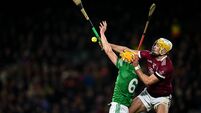Gary Brennan: Galway need 18 points to win...and they might just do it

SCORING THREAT: Shane Walsh of Galway. Photo by Ramsey Cardy/Sportsfile
FROM early in the year, I had Kerry as my favourites to win the All-Ireland - my reasoning being that I felt there were fewer questions around them than any of the other leading contenders.
This was reinforced as the National League developed and they seemed to have added a meanness in defence that perhaps had been lacking previously. You’d imagine the fact they eventually overcame the Dublin obstacle - plus the resilience they had to demonstrate in doing so - would increase my confidence in them, but the closer we get to Sunday’s decider, the more I’m beginning to wonder.
Much has been made of the aforementioned improvement in Kerry’s defence and with some justification. They have conceded an average of 12 points across their championship games and only one goal in total.
For those ready to argue about the quality of opposition in earlier rounds, the average across their entire Division One league campaign was just 13 points with two goals conceded in total. If the game against Tyrone is discounted (a dead rubber for Kerry in which they conceded 1-15), the concession average is in line with championship to date.
Compare this to Galway, averaging just over 15 points per game (excluding ET against Armagh) and the balance of favour seems to be with Kerry. They are clearly placing huge value on clean sheets and Tadhg Morley is doing an excellent job filling the central channel. However, any system or shape (or whatever you wish to call it) is about manipulating space, and every team leaves space somewhere.
Against Dublin, particularly in the first half, Kerry marked tightly along the 45m line and even on the sidelines, which left large pockets behind the half-back line, either side of the D. Maybe that was Kerry cutting their cloth to measure and perhaps the breeze was a deterrent but Dublin seemed intent on working it through the hands more than looking inside. In the second half, when Dublin tried a couple of direct balls over this half-back line, they had some joy. I think Damien Comer gives Galway the option to exploit this space more than Dublin did.
His lateral runs across that inside line can draw Morley to one side and present opportunities for the diagonal ball – the type of ball John Daly managed to squeeze through to Comer for his second point against Derry. Comer also offers the option of a high ball to the back post, which Galway have tried plenty of times this year.
It has yet to result in a goal but he has come very close. When Morley is occupied with runners behind him, it leaves those channels either side of the D available for accurate shooters. Dublin had five wides from these positions in the first half of the semi-final, but Mayo exploited it quite well early in the quarter-final when their shooting was sharp.
Galway have had some hairy spells of shooting (the first 20 minutes against Derry being a prime example) but equally, they have the potential to match and even better what Mayo did when they are on song.
The other area where space could be exploited against Kerry is along the endlines, or with the backdoor run as people like to call it. James McCarthy, Seán Bugler and Paddy Small all got half-goal opportunities last time out using this space. The impressive thing from a Kerry perspective was how many bodies saw the danger and got back to make sure those were only half chances, but had there been more runners committed forward by Dublin (in the way Johnny Heaney often pops up at the back post for Galway), there may have been goals there. Shane Walsh’s pace has also troubled Kerry in these areas in the past.
In highlighting these potential areas of joy for Galway, I’m very aware that they have demonstrated frailties of their own. They too prioritise getting bodies in the central channel which leaves similar spaces for Kerry’s shooters and though their swarm tackling improved against Derry, Roscommon in particular found ways to get goals even when Galway had plenty of bodies back. If they want their half-back line to sit back as they have tended to do, it potentially leaves Paudie Clifford and Seán O’Shea with more room to manoeuvre in the middle third, and they would certainly fancy their chances of making things happen regardless of how many Galway have in front of them. Galway have also struggled to deal with high ball which was the source of at least 1-1 for Kerry last day out.
And so, much of it comes down to who has the ball. Turnovers, especially in the middle third offer the best opportunity to get at defences before they are set up, so minding the ball there will be crucial. When Dublin sat off Kerry in this area in the first half, Kerry’s kicking game was excellent, but increased pressure in the second half meant Kerry gave the ball back nine times. Galway seem to have a likeness for giving the ball away once they have established a lead. But, both teams are comfortable keeping the ball for long spells.
The other way of taking possession from the opposition is kickouts. When Dublin aggressively went man-to man and forced Kerry long in the second half, they won two of three and scored 0-2 directly from them. Kerry reacted with a bunch and break and excellent hard runs by their defenders allowed them to go short. Galway’s zonal press can close this down but the question is how brave do they want to be?
If they push five up into the full forward as they did against Derry, it will force Kerry long but Kerry have more long options than Derry did and the risk is they leave themselves majorly exposed at the back. Going after the opposition kickout sends out a message that you are coming to challenge, not to contain. Kerry didn’t do so against Dublin, allowing them short, but set their trap further back the field. Conor Gleeson has come under pressure at various stages, however, and they might be tempted to put the squeeze on early.
Watch out also for the throw-ins. Galway have a 100% record in the All-Ireland series (all four v Armagh and two v Derry) but interestingly, this has only led to 0-2, both from frees. Their set play was most effective against Mayo in the first round of the Connacht championship when they found Shane Walsh running outwards from the 14 position and he pointed from play.
Kerry, for their part, have won three out of four (one against Mayo and two v Dublin) but have kicked the ball away immediately on all three occasions. I suspect they might have a trick up their sleeves this time if David Moran can get his hands on it ahead of Matthew Tierney.
With all that said, it comes down to Galway needing at least 18 points to win. If they find a way to get two goals, that will really shake Kerry’s belief and take them somewhere they haven’t been this year. Even with 18 points, they will still have to produce their best defensive display of the year to win. There’s an argument that Kerry will grow from getting the Dublin monkey off their back and become even better, but where would that improvement be visible? Perhaps a greater speed of play, less turnovers and even better shooting. If they do, Galway may struggle to keep pace.
Kerry have more experience of the occasion, have never played outside of Division One and have the Jack O’Connor's winning touch. But since Padraic Joyce came in, he has very clearly stated that their aim was to win Sam. For those Galway players, they are now where they were always meant to be, in their minds, and they are playing with a confidence reflective of their managers’ personality, even when things look as though they are going against them.
The evidence thus far says Kerry - but new evidence can always be found.








